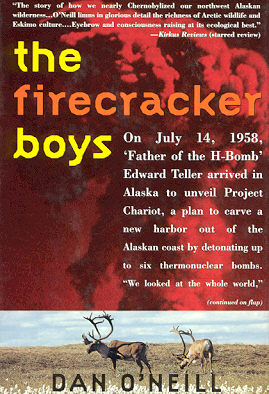

| THE FIRECRACKER BOYS Dan O'Neill New York: St. Martin's Griffin, 1994 |
Rating: 5.0 High |
|||
| ISBN-13 978-0-312-13416-7 | ||||
| ISBN 0-312-13416-9 | 388pp. | SC/BWI | $14.95 | |
Project Plowshare, an attempt favored by President Eisenhower to demonstrate peaceful uses for atomic energy, focused primarily on using bombs for earth-moving work. Before this sort of work could be undertaken, more data were needed on the various types of soils likely to be encountered. Project Chariot was to be the first "shot" in this data-gathering effort. It was planned for a remote area on the northwest coast of Alaska, thirty-one miles from an Inupiat village of about 600 souls, and would have taken place around 1961.
Dan O'Neill is a Research Associate with the University of Alaska at Fairbanks. Here, with meticulous care, he documents the history of Project Chariot. It is a tale replete with tragicomic errors and deceptions on the part of the AEC and the staff of Lawrence Livermore National Laboratory (then called Lawrence Radiation Laboratory, or LRL) including Dr. Edward Teller, known as the father of the H-bomb.
At that time, in the late 'fifties, the AEC had already acquired a reputation for mendacity (lies — see page 67)1 with respect to the dangers of nuclear technology. The pitches for Project Chariot proved to be more of the same. O'Neill follows Dr. Teller and other AEC personnel as they make visits to Alaska, and frequently reports entire conversations between them and the groups to whom they speak. Letters and other documents, some recently declassified, complete the picture. (Among the most telling exchanges is one that took place at Point Hope — site of the Inupiat village — on 14 March 1960. Among the items of modern technology the Inupiat embraced are portable tape recorders. Thanks to these, we know what was said there.)
Exhaustively detailed though it is, the book deserves to be read in its entirety. However, for those short of time, chapters 9 and 10 will certainly get the point across. Chapter 9 quotes a large part of the Point Hope presentation. Chapter 10 examines the selling points made by the AEC men there, refuting them one by one. It draws heavily on the report of a 1979 Congressional investigation into the AEC's handling of atomic testing in general. The sins of the AEC are laid bare in breathtaking fashion. I'll mention just one example. An AEC study subjected sheep to radioactive iodine. Its conclusions? Only that the first generation of lambs born were "normal in size" and later generations showed "a significant reduction in birth weight". It turns out that the first lambs had thyroid abnormalities, and subsequent litters were either stillborn or died shortly after birth. [Page 140] This is typical of the "science" presented by the AEC.
With Chariot, which the AEC finally shelved in 1962, the pitch included claims that radiation release from the 280-kiloton blast (downsized twice from 2.4 Megatons) would be negligible, or even undetectable. Meanwhile, an internal memo estimated a release on the order of 1.5 BILLION Curies. For comparison, Chernobyl spilled "only" 40 to 86 million Curies.
Yes, it is a sordid story — and would be far more so but for the brave people whose efforts Dan O'Neill records in this important account.

 To contact Chris Winter, send email to this address.
To contact Chris Winter, send email to this address.